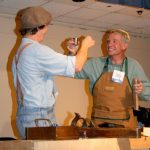We may receive a commission when you use our affiliate links. However, this does not impact our recommendations.
I can see the headlines now: “Schwarz Loves Nazi Buttocks.”
Oh well, it has been worse than that lately.
An astute reader – Mark Firley – was doing some deeper research on the Moravian-style stool published in the December 2012 issue of Popular Woodworking Magazine. (See more information on the stool here or download the SketchUp model here.) During his search, he found that the German military used this same style of stool in its barracks.
Read all about the German stool here.
 There are several interesting things about this military stool compared to the examples I saw at Old Salem in Winston-Salem, N.C. The military stool uses a seat that is in two pieces instead of the single plank used by the Moravian examples. Using two pieces will likely eliminate the propensity of the stool’s seat to split over time. And the two-piece seat allows the maker to use narrower lumber.
There are several interesting things about this military stool compared to the examples I saw at Old Salem in Winston-Salem, N.C. The military stool uses a seat that is in two pieces instead of the single plank used by the Moravian examples. Using two pieces will likely eliminate the propensity of the stool’s seat to split over time. And the two-piece seat allows the maker to use narrower lumber.
So that’s a good thing – if you like the look of the two-piece seat. I’m not too fond of it. I’d prefer to have a one-piece seat that had a split. But I’m an admitted weirdo. (By the way, the seat on the stool I built in the summer hasn’t split yet. Thanks for asking.)
The other notable change in the military example is that the two cross-battens below the seat are pegged into the underside of the seat. The Moravian examples I saw used a sliding dovetail. Obviously, pegging the battens into the seat saves a lot of time. It also is a weaker joint.
And finally, the legs are turned instead of tapered octagons. I’ve seen Moravian examples with turned legs. The turned legs are probably faster to make if you have to make thousands of stools.
So if you are afraid of wood movement and sliding dovetails, the German military example might allow you to make the stool with your stock and current set of skills. Personally, I’m sticking with the Moravian original.
— Christopher Schwarz
Hey, did you know that I have a new DVD out on “Super-tune a Handplane?” It shows you how to take a solid (but old) user and convert it into a precision instrument, from the bones up. It’s available at ShopWoodworking.
Here are some supplies and tools we find essential in our everyday work around the shop. We may receive a commission from sales referred by our links; however, we have carefully selected these products for their usefulness and quality.











Looks like Nikk is right. I think the cunning baskets have made blind dovetails in both seat boards, open at the inner ends, then slid them over the cross battens which look to have dovetails on the top surface, again not exposed on the outer ends, and then the pegs have been fitted when its all together.
I don’t mind the two board seat but it appears as if the legs are not through morticed and wedged. Is that because of the lack of a single board? Perhaps I am misinterpreting how the battens are pegged.